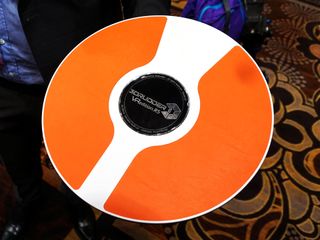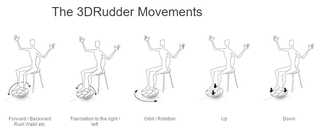3DRudder VR Foot Controller Steering Towards March Launch

Last year at CES, we stumbled across 3DRudder, a foot controller for VR made by a French company. We were frankly impressed by how mature the product seemed to be even then, and now, a year later, 3DRudder is nearly ready to launch.
The device itself is attractive on its own, but it’s also an example of what is probably the wisest way to develop a VR peripheral. The idea and the execution are both rather simple but powerful.
3DRudder, Then And Now
The 3DRudder is a half sphere, with a rounded bottom and a flat top. The top has two spots for your two feet, and it allows you multiple controls, which are best explained by this simple image:

From when we saw 3DRudder a year ago until now, the device has new hardware and a more refined final design. Another major change from last year’s model is that, according to 3DRudder CEO Stanislas Chesnais, more of the processing is now done on the 3DRudder itself as opposed to on the PC to which it’s connected.
Under the hood, there’s an IMU (inertial measurement unit) that handles the sensor data and calculations. This is in addition to an accelerometer and gyroscope. There’s also a pressure sensor on top that detects when, for example, you press in two different directions with your feet (eg, your right toe and left heel press down at the same time, or vice versa). It affords multiple degrees of freedom.
Chesnais (half) joked that you can hold a drink while flying around a game with the 3DRudder, but joking aside, it’s a good point. If you can offload your in-game movement from your two hands to your feet, that frees you up to use other input devices such as the hand controllers used by the Oculus Rift and HTC Vive for things like grabbing objects and firing weapons.
In some ways, it’s a solution to the whole-room VR problem. It is true that walking around in a VR world is natural and intuitive, but it’s also enormously problematic. Most people won’t be able to take more than a few steps in any direction before bumping into walls, furniture or friends.
Stay on the Cutting Edge
Join the experts who read Tom's Hardware for the inside track on enthusiast PC tech news — and have for over 25 years. We'll send breaking news and in-depth reviews of CPUs, GPUs, AI, maker hardware and more straight to your inbox.
The Virtuix Omni VR treadmill is at this point the best solution to that problem, but it’s no silver bullet. It probably won’t be cheap, and even so, it’s bulky and will therefore not be an option for many VR enthusiasts with limited space. CloudHead Games’ Blink is another workaround, but it’s just a clever teleportation sort of solution.
Brilliant Simplicity
The foot controller is responsive and easy to learn, but the best ideas 3DRudder had was to make it easy to integrate with games and other devices. It connects to your PC with just a USB Type-A port, so it’s a plug-and-play device, and you can adjust the settings via an app. Think of it like a joystick, and all the mapping you can do with one. You can, for example, remap various mouse and even keyboard controls and commands to the 3DRudder.
Chesnais also told me that the app also lets you “customize the response curves for each movement,” which is another way of saying that you can adjust the sensitivity on the 3DRudder just you would alter DPI on a mouse.
This simplicity is perhaps a template for other VR peripheral makers to follow. Setting up a whole VR rig is going to be enough of a chore without having to deal with fussy peripherals. 3DRudder is ostensibly a painless but powerful add-on: Plug it in, tweak some settings if you like, and off you go.
However, on top of that, 3DRudder has been courting game studios to officially support the foot controller to enable additional functionality. “The game studio can adjust the speed and the action you do,” explained Chesnais. For example, he noted, they can tweak how fast you go in a given game, and they could make a rapid, hard forward tilt translate into a jump.
Here's a video demo 3DRudder made with The Witcher 3:
Beyond that, the goal is easy integration. “The objective is that should the game detect a 3DRudder hooked to the PC, it automatically switches to using the 3DRudder,” said Chesnais.
You can currently preorder a 3DRudder for $175. It will begin shipping in March, with a number of different color options available.
Seth Colaner is the News Director for Tom's Hardware. Follow him on Twitter @SethColaner. Follow us on Facebook, Google+, RSS, Twitter and YouTube.
-
billybobser Will there be a sewing machine simulator to coincide with its launch?Reply
Terrible peripheral for immersion. -
bloodroses75 It looks an aweful lot like the NES Rock N Roller; which was really bad btw....Reply
http://www.i-mockery.com/minimocks/nes/22.php -
AnimeMania I almost never run sideways when playing video games. It seems like this peripheral might make that easier/more intuitive to do so.Reply -
R_Izq Perhaps this controller would help out to relief syndroms associated with the extended use of Mouse/Keyboard, for example tendon injuries or RSI (Repetitive strain injury). After all the article says that Mouse and keyboard actions can be remaped.Reply -
uglyduckling81 The inputs look quite delayed. Probably a 1.5 second delay. Also the side to side motion didn't work very well. I don't see much of a market for this device.Reply
Give me the walking frame thing so I can full immerse in FPS games and I'm sold if it's not too expensive. It looks much better. -
cryoburner ReplyWill there be a sewing machine simulator to coincide with its launch?
Terrible peripheral for immersion.
No, but I hear they're planning a cat-riding-Roomba simulator. : D
I'm sure it can't be any worse for immersion than the Xbox controller that Oculus is shipping with its headsets. The real draw of something like this is that it frees up your hands for more immersive VR inputs, such as hand-tracking or firearm-style controllers, while leaving your leg movements to be controlled by your legs, albeit in a somewhat abstracted way.
The price of this unit seems a bit high for what it is though. There's little reason it should cost much more than a regular gamepad, aside from being a niche device sold to early adopters.
Give me the walking frame thing so I can full immerse in FPS games and I'm sold if it's not too expensive. It looks much better.
The Virtuix Omni looks like it could be cool, but it's also $700. Additionally, it seems like the Omni requires a fair amount of setup before you get into a game, since you need to put on special low-friction shoes and strap yourself into a multi-point safety harness, in addition to preparing your other VR gear. And of course, you're locked into the thing, so if, for example, you need to get something from across the room, you'll first need to spend another couple minutes removing all of this equipment. Also, since you're literally running around in games, you could easily get worn out from playing a high-intensity game for just a short while, so you might not want to play in an FPS for too long. On the other hand, you're bound to get a workout. : P
Another possible option would be to make something like a cross between the two. A low-friction surface like the Omni designed for use while seated in a chair. That way, one could slide their feet in a way roughly similar to walking, without needing to strap into a harness and lock yourself into an immobilizing device. You would still get some exercise, though it would likely make longer play sessions less tiring. It could also be far more compact and portable, so you wouldn't need to dedicate a corner of a room to the device. The smaller size and lack of any need for a heavy-duty frame and harness system could also allow it to be much lower-priced. Socks could even be used in place of dedicated shoes to help lower the price further. I suspect we'll see something like that before long, maybe even from Virtuix themselves.
Most Popular


